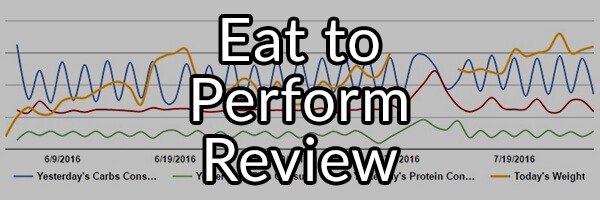Last June, my goal was to put on lean muscle tissue without gaining too much fat. I met with Eat to Perform coach Jason Miller who collected some information from me and ran my data through a calculator. He told me that by the end of the summer, I could gain fifteen pounds of muscle without gaining much fat. His prediction was accurate to the pound.
How does it work? You’ll need a Fitbit Charge HR and a MyFitnessPal account. The Fitbit gives you information about your energy expenditure and MyFitnessPal tracks energy intake. When you collect enough data using the Eat to Perform tools, your coach will notice trends based on your weight and performance in the gym. Each week, I would touch base with my coach and he would tell me which adjustments that I would need to make to my macronutrient intake. Here’s a look at some of my data:

At first, the challenge was nailing my macronutrient values. I had to learn how to plan my meals in advance in order to meet my daily intake. With Eat to Perform, you are allowed to be off by as much as 10g of protein and carbohydrates, and 5g of fat, so you get a little bit of wiggle room, but you still have to plan. Realistically, you are not going to accidentally eat the right amount of food unless you do. To keep track of your daily food intake, you are required to use the app, MyFitnessPal, and you are also required to get a FitBit Charge HR to track your activity level.
I was a bit skeptical at first because there are a host of variables that could throw off your data. I have read the reviews for the Charge HR and reports were claiming that it was off by as much as 20%. Given the acceptable deviation from the diet plan (10g of protein and carbs, 5g of fat), it would seem that 20% is too high. I was also skeptical that the accuracy of nutrition labels might also throw off the data. There are also a ton of metabolic variables that are impossible to calculate, and lets not forget the microbiome. So, why were my results so predictable? Well, after analyzing my data I found that due to the daily tracking over a long period of time, it is easy to see the trends. Unless your metabolism and microbiome are extremely volatile, your bathroom scale ends up being the constant and weight management becomes more simple.
The downside to Eat to Perform is that it takes a bit of extra time to plan your meals, weigh your food, and track your data. They have made it a lot simpler by creating Google Sheets that automatically pull your data from MyFitnessPal, but you still have to input your activity data, workouts, and sleep. All-in-all, I’d say that I spent less than fifteen minutes a day on this, so for me, the results were worth the extra time.
I was impressed with the level of accuracy that my Eat to Perform coach, Jason Miller, was able to provide. I think that it is a great program especially for strength athletes looking to improve in the gym. If you are a coach potato, or a chronic cardio nut, maybe it’s not worth it for you, unless you would consider starting a strength training program.
Check out the Eat to Perform website. Even if you decide not to join, there is a lot of good information on the site that is free including a free macro calculator in case you want to try and design your own program. I highly recommend getting a coach. Just having to be accountable to someone has extraordinary benefits, so most will find that paying for a coach is a better value than going it alone.







What? No topless before and after photos ;/